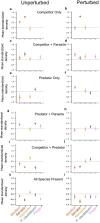Weakly interacting species as drivers of ecological stability
- PMID: 40495812
- PMCID: PMC12152744
- DOI: 10.1098/rspb.2025.0604
Weakly interacting species as drivers of ecological stability
Abstract
Determining how individual species can act to moderate the stability of entire ecosystems is a pressing challenge in a world undergoing rapid environmental change. Here, we show that even very weakly interacting species with no discernible effect on ecological dynamics can contribute substantially to ecosystem stability. Further, the nature of this contribution depends on biotic context, and both the type and complexity of interspecific interactions in the community. By manipulating multitrophic aquatic microcosm communities experimentally, we found that the contributions of a bacteriophage parasite to overall system stability following a pulse perturbation were variously stabilizing, destabilizing and neutral, depending on the presence of competitor or predator species of its bacterial host. This was despite the phage itself having no detectable effect on the biomass or growth rates of its host. Our results demonstrate the pivotal importance of both weak and indirect interactions in moderating the stability of whole ecological networks, and have profound implications for our ability to predict the consequences of perturbations on ecosystems.
Keywords: community ecology; ecology; experiment; microcosm; species interactions; stability.
Conflict of interest statement
We declare we have no competing interests.
Figures




References
-
- Tilman D, Wedin D, Knops J. 1996. Productivity and sustainability influenced by biodiversity in grassland ecosystems. Nature 379, 718–720. ( 10.1038/379718a0) - DOI
MeSH terms
LinkOut - more resources
Full Text Sources

